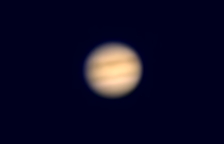D850 DSLR tests: Jupiter, Saturn, Swan Nebula
Posted: 5 September 2020
|
Open: Friday, 4 September 2020, 1825 MST Temperature: 93°F |
Session: 1514 Conditions: Mostly clear |
Equipment:
12" f/8 LX600 w/StarLock
2" 24mm UWA eyepiece
2" 2X Powemate
Camera:
iPhone 11 Pro Max
D850 DSLR
1832 MST: began relaxing on the observatory patio bench.

1844 MST: spotted Jupiter naked eye.
1846 MST: sunset.
1859 MST: Saturn naked eye visible.
It is always so nice to watch the stars come out while listening to music from the Hearts of Space.
1905 MST: the Summer Triangle stars of Vega, Altair, and Deneb were now all visible.
1930 MST: now inside the observatory. Prepared the D850 DSLR for imaging.
1938 MST: LX600 ON, StarLock OFF, High Precision OFF.
Viewed Jupiter and the four Galilean Moons, 102X and 203X.
Attached the Astrozap AstroCap mask to stop down the 12" aperture for planet imaging tests. The view of Jupiter, 203X, was pretty good at times, although seeing was not very good. Mounted the D850 DSLR at prime focus + 2X Powermate. Took this images.
Jupiter, 1080p 60fps, 1/125sec, ISO 2500, White Balance 5560K, stack of 658 video frames

Jupiter and 4 Galilean Moons, 1/10sec, ISO 6400, White Balance 5560K

Saturn, 1080p 60fps, 1/60sec, ISO 8000, White Balance 5560K, stack of 601 video frames

Although seeing was not very good, the tests with the mask to stop down the aperture were not that successful as the resolution was reduced.
I also did some test images using the three Raw image sizes available on the D850 DSLR (8256x5504, 6192x4128, 4128x2752) to see if there was any improvement using one of the sizes. As expected, the largest size was the best.
2012 MST: the Milky Way looked very nice overhead.
2021 MST: the eastern sky was brightening from the rising waning gibbous Moon.
Focused on Altair, locked the primary mirror, and slewed to M17 (Swan Nebula).
2023 MST: StarLock ON.
After doing some framing test images, I did some test images at the three Raw image sizes, prime focus + 2X Powermate, StarLock autoguided, 5 minutes, ISO 6400, WB 5560K. Again, the best image was using the largest size, which also allowed from the best cropping.

Seeing was still not very good for imaging.
2052 MST: StarLock OFF.
Viewed M17 (Swan Nebula), 203X and 102X.
2100 MST: LX600 OFF.
|
Close: Friday, 4 September 2020, 2111 MST Temperature: 84°F |
Session Length: 2h 46m Conditions: Mostly clear |
My review of the Explore Scientific 2" UHC Filter has been posted.
Comments are welcome using Email. Twitter users can use the button below to tweet this report to their followers. Thanks.
Cassiopeia Observatory Home Page
Copyright ©2020 Michael L. Weasner / mweasner@me.com
URL = http://www.weasner.com/co/Reports/2020/09/05/index.html
